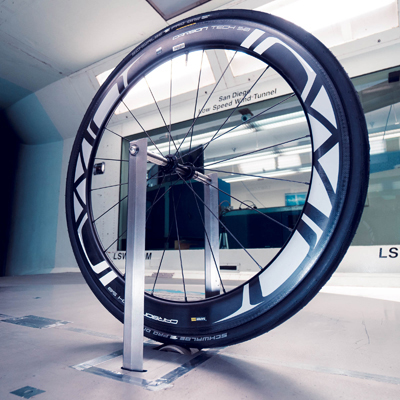Though we pride ourselves on the fact that our products are all “innovation driven, race proven”, we’re also not afraid of going toe to toe with “the Big Boys” in the industry. We have always believed that our products speak for themselves, but in a data driven sport like cycling, wind tunnel testing provides a relevant technical starting point.
We spent time in the fabled San Diego Low Speed Wind Tunnel recently, and put our wheels and the “industry leader” in aerodynamic wheels in direct comparison using the LSWT’s industry-accepted protocols. Needless to say, we were anxious to see how our modestly priced $1700 AON TLR 58 would stack up against the $2200 competition.
Much to our delight- and admitted surprise- the AON TLR 58 beat the leading wheelset in all yaw angles.
AON TLR 58 VS LEADING BRAND

Significantly, the AON TLR 58 was far superior at the steeper yaw degrees, which translates into a much more stable and controllable wheel in crosswinds. In the real world, that means that you spend less time fighting to maintain a steady, straight line. And, if the saying that “aero is faster” holds true … the AON TLR 58 is the faster wheel too.
With a cost savings of $500 between the two wheelsets, and a wattage savings as well, the AON TLR 58 wheelset truly exceeds expectations while beating the competition.
BUT WHAT DOES IT MEAN?
Most of us don’t ride in wind tunnels, which sometimes makes the data harder to understand without context. So what does the data mean?
Well, the most obvious thing first; the AON TLR 58 is simply faster, by virtue of less wind drag, at all the tested yaw angles. That’s the easiest thing to understand. It means that less drag requires less energy (power/watts) to propel the wheels forward. So you spend less energy to keep the wheels moving forward, due to less drag from the wind. Over a longer race or ride, that means you expend less energy, and have more left over for the finish- or to go faster for the duration of the event. That comes in pretty handy in situations like triathlons, where you need to transition to the run after your ride. That also comes in handy for sprint finishes at the end of rides or races, saving you precious watts for when you need them most.
One thing that is often not explained enough is what it means to your ride experience. Lower drag numbers- especially at steeper angles- means that the wheels handle better, requiring less input from the rider to keep the bike going in a straight line. Now, this might not be a big deal to larger, heavier, stronger riders, but for smaller, lighter riders this can be a huge influence on wheel choice for a given ride or race. And, as we’ve seen from the data, faster wheels are theoretically better. But if you’re fighting to maintain a straight line, or hold your position in the pack, you are wasting any aero savings you might be gaining by using deeper profile wheels. So those lower numbers and steeper yaw angles become more significant pretty quickly.
So, not only will the AON TLR 58 make you faster in a straight line, they are easier to keep going in a straight line! And, with the money savings, you can afford other aero equipment like a new aero helmet or skinsuit … and go even faster still!
So while the AON TLR 58 is fast in the tunnel, it’s even faster on the road, in real world conditions. And when you factor in the extra-smooth spinning ceramic bearings that also save you watts, you have an unbeatable performance package- regardless of the price.
